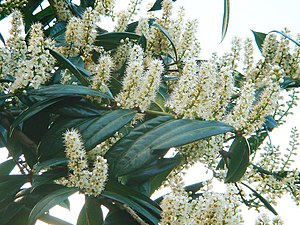Difference between revisions of "Prunus laurocerasus"
Jump to navigation
Jump to search
m (1 revision: Prunus laurocerasus) |
(start article) |
||
| Line 1: | Line 1: | ||
| − | |||
{{Taxobox | {{Taxobox | ||
| image = Karayemiş-8.jpg | | image = Karayemiş-8.jpg | ||
| Line 29: | Line 28: | ||
}} | }} | ||
| − | '''''Prunus laurocerasus''''', also known as '''cherry laurel''', '''common laurel''' and sometimes '''English laurel''' in [[North America]], is an evergreen species of cherry (''[[Prunus]]''), native to regions bordering the [[Black Sea]] in southwestern [[Asia]] and southeastern [[Europe | + | '''''Prunus laurocerasus''''', also known as '''cherry laurel''', '''common laurel''' and sometimes '''English laurel''' in [[North America]], is an evergreen species of cherry (''[[Prunus]]''), native to regions bordering the [[Black Sea]] in southwestern [[Asia]] and southeastern [[Europe]]. |
| − | The | + | The fruit look much more delicious than they taste. The resemblance to other ''Prunus'' is unmistakeable but they are sometimes very bitter and astringent, and even when not bitter the astringency is still there. Cooking or preservation might improve the flavor. |
| − | |||
| − | |||
| − | |||
| − | |||
| − | |||
| − | |||
| − | |||
| − | |||
| − | |||
| − | |||
| − | |||
| − | |||
| − | |||
| − | |||
| − | |||
| − | |||
| − | |||
| − | |||
| − | |||
| − | |||
| − | |||
| − | |||
| − | |||
| − | |||
| − | |||
| − | |||
| − | |||
| − | |||
| − | |||
| − | |||
| − | |||
| − | |||
| − | |||
| − | |||
| − | |||
==References== | ==References== | ||
{{Reflist}} | {{Reflist}} | ||
| − | + | {{Ack-Wikipedia}} | |
| − | {{ | ||
| − | |||
| − | |||
| − | |||
| − | |||
| − | [[Category:Prunus | + | [[Category:Prunus]] |
| − | + | [[Category:Plants Keenan has eaten]] | |
| − | |||
| − | |||
| − | |||
| − | |||
| − | |||
| − | |||
| − | |||
| − | |||
| − | |||
| − | |||
| − | |||
| − | |||
| − | |||
| − | [[Category:Plants | ||
Latest revision as of 19:27, 20 August 2018
| Prunus laurocerasus | |
|---|---|

| |
| Foliage and flowers | |
| Scientific classification | |
| Kingdom: | |
| (unranked): | |
| (unranked): | |
| (unranked): | |
| Order: | |
| Family: | |
| Genus: | |
| Subgenus: | |
| Section: | Laurocerasus
|
| Species: | P. laurocerasus
|
| Binomial name | |
| Prunus laurocerasus | |
| Synonyms[3] | |
|
List
| |
Prunus laurocerasus, also known as cherry laurel, common laurel and sometimes English laurel in North America, is an evergreen species of cherry (Prunus), native to regions bordering the Black Sea in southwestern Asia and southeastern Europe.
The fruit look much more delicious than they taste. The resemblance to other Prunus is unmistakeable but they are sometimes very bitter and astringent, and even when not bitter the astringency is still there. Cooking or preservation might improve the flavor.
References
- ↑ Prunus L. subg. Cerasus: USDA, ARS, National Genetic Resources Program. Germplasm Resources Information Network - (GRIN), National Germplasm Resources Laboratory, Beltsville, Maryland. (12 April 2013)
- ↑ Rehder, A. 1940, reprinted 1977. Manual of cultivated trees and shrubs hardy in North America exclusive of the subtropical and warmer temperate regions. Macmillan publishing Co., Inc, New York.
- ↑ "The Plant List: A Working List of All Plant Species". Retrieved January 27, 2014.
Acknowledgements
This article uses material from the Wikipedia article Prunus laurocerasus, which is released under the Creative Commons Attribution-Share-Alike License 3.0.